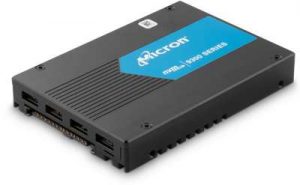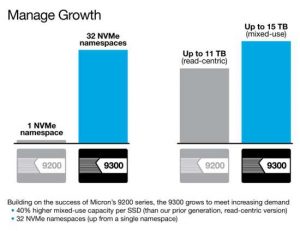Micron 9300 Series NVMe U.2 Up to 15TB SSD
Up to 3,500MB/s and from 3,100MB/s to 3,500MB/s sequential RW, 850,000 and 310,000 RW IO/s
This is a Press Release edited by StorageNewsletter.com on April 29, 2019 at 2:28 pmMicron Technology, Inc. unveiled its series of SSDs featuring the NVMe protocol, bringing industry storage performance at higher capacities to cloud and enterprise computing markets.
The 9300 series of NVMe SSDs enables companies with data-intensive applications to access and process data faster, helping reduce response time.
“The introduction of our third generation of NVMe SSDs endorses our tradition of continued innovation for cloud and enterprise markets,” said Derek Dicker, corporate VP and GM,storage business unit, Micron. “The Micron 9300 is our flagship series of NVMe SSDs, which feature industry-leading sequential write performance and latency, increased capacities, and delivery of a 28% reduction in power over the previous generation.“
Enterprises deploying cloud infrastructures require systems that can store, retrieve, process and quickly analyse massive amounts of business-critical data. Driven by this need, many enterprises are transitioning primary storage from SATA-based SSDs to NVMe. (1) The 9300 series equally balances its 3.5Gb/s throughput on both reads and writes to deliver faster response times for data-centric applications in comparison to other NVMe SSDs available on the market. Combined with its write latency and sequential write performance (*), the 9300 series excels in the most demanding data centre environments.
Data centre system designers not only value performance criteria such as throughput and latency, but also the ability to maximise the use of infrastructure and lower the TCO. This series of drives performs nearly nine times faster (2) than enterprise SATA SSDs and is 35% more efficient. (3) The 9300 series consumes 28% less power than earlier NVMe drive generations, helping reduce operational costs. The availability of the SSDs in high capacities allows customers to scale according to their changing storage needs and keep up with data growth.
“Support for massive amounts of fast storage in a server is a key feature of the AMD EPYC processor and is critical to our customers,” said Raghunath Nambiar, corporate VP and CTO, data centre ecosystem and application engineering, AMD (Advanced Micro Devices, Inc. ). “With 128 lanes of PCIe available in a single socket, the AMD EPYC processor is an ideal match for the new Micron 9300 NVMe drives and for the data-centric workloads such as database applications, big data analytics and software-defined storage solutions that are increasingly found in the modern data centre.“
The 9300 series provides storage densities that were once reserved only for HDD drives by offering capacities up to 15.36TB. Large capacities and up to 32 NVMe namespaces allow enterprises to tailor deployments more efficiently for maximum storage use.
Highlights 9300 Series NVMe SSDs:
-
850,000 read and 310,000 write inputs/outputs (IO/s (**)).
-
Up to 15.36TB enable per-rack storage density that outperforms the densest HDDs.
-
Data-integrity features such as data-path protection, power-loss protection for in-flight and at-rest data, sanitise crypto erase.
Availability:
The 9300 series of NVMe SSDs is available. It is offered in two versions with varying endurance and performance characteristics:
-
The 9300 PRO series is designed for read-intensive workloads and offered in capacities of 3.84, 7.68 and 15.36TB.
-
The 9300 MAX is geared toward mixed-use applications and offered in capacities of 3.2, 6.4 and 12.8TB.
-
Both versions will be available in U.2 (2.5-inch, 15mm) form factor, support PCIe Gen3 x4 NVMe and be rated for MTBF of 2 million hours.
(*) Based on the best SKU in each NVMe high-performance product family’s U.2 (15mm) form factor and information in public competitor data sheets accessed February 1, 2019. Actual performance may vary.
(**) Based on maximum data sheet specifications. Performance specifications vary by model, capacity and form factor.
(1) G2M Research Releases Fall 2018 NVM Express Market Sizing Report
(2) 9300 PRO vs 5200 ECO (7.68TB) datasheet spec for random read performance (850,000 vs. 95,000)
(3) 9300 PRO vs 5200 ECO (7.68TB) datasheet spec for sequential read performance and power (3,500MB/s at 12W vs. 540MB/s at 2.5W)
















 Subscribe to our free daily newsletter
Subscribe to our free daily newsletter

